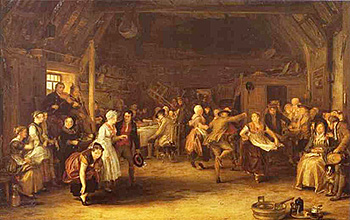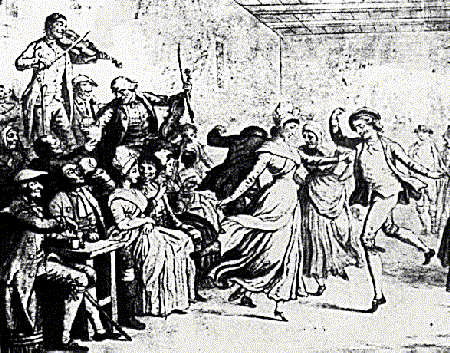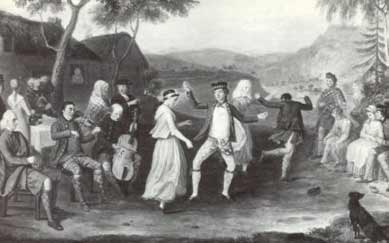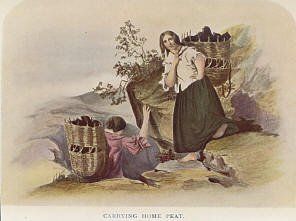
The three principal domestic events - marriages, births, and deaths - provided rare holidays for Scots. They were opportunities for social gatherings in a life which, for the most part, consisted of an unceasing round of toil. As you will have guessed, this essay focuses on weddings. I had hoped, as much as possible, to describe lowland Scottish weddings in the 18th century; however, it was difficult, especially with information from websites, to determine the century and the location (i.e., Highland or Lowland) of their information. What follows, therefore, is an amalgam of Scottish wedding customs. I'll start by describing what were known as penny weddings or penny bridals.
In Lowland Scotland, the celebration of the union of man and woman has always been attended by a bridal. This is an old Anglo Saxon word and consists of two words co-joined; BRYD meaning bride or woman and EALO meaning ale or beer. Thus, in this context, the bridal is a bride's drinking party.
In the past, Lowland Scots weddings were called Penny Bridals or Siller Bridals. It is difficult to say when Penny Bridals began. They were certainly the most important occasions for singing and dancing, and the festivities and were immensely popular. They were attended by whole communities, as many as two hundred participants being not uncommon. Invitations, although given, were not specifically required and everyone attending was expected to contribute money for being allowed to attend, hence the name Penny Bridal. Contributions were usually in the form of a penny, although I read of the contribution being a shilling, although I expect that this applied to later years. I also read that contributions could be in the form of food, service, etc. The theory behind the practice was that each person would contribute money towards the cost of the wedding and whatever money was left over would help the couple establish their new home.
Supposedly, penny bridals were formally abolished in 1645, presumably because of the disorder they brought to a community. Bridals would begin several days before the actual wedding. Since each guest paid a penny for the privilege of taking part in the festivities, they made sure that they got good value for their penny. So great was the uproar often made by these paying guests, that one parish passed an act restricting the number of persons at weddings to twenty. Proscribed or not, penny bridals continued into the 1800s. For example, many parish ministers writing in the Statistical Accounts in 1790 disapproved or, or roundly condemned the penny bridals for the disorder, drunkenness and quarreling that ensued. When the marriage was at a farm, the barn would be allotted for the dancing and the house for the drinking. In villages, the guests were at times divided into parties and feast spread over several houses. Sometimes, if the weather were amenable, the event would be held on the green. And thus, they would make merry for two or three days, until Saturday night.

Here's a description of a more traditional wedding ceremony without the two or three days of advance partying.
The wedding celebrations started on the eve of the wedding with plenty of singing, drinking and toasting to health. On the eve, a ceremonial feet washing was held. A tub of water was placed in the best room. The bride placed her feet in the tub and her female friends then gathered around to help wash them. A wedding ring from a happily married woman was previously placed in the tub and it was believed that whoever found the ring while washing the bride's feet would be the next to get married. The men folk were outside the door making jokes and attempting to watch through the doorway. The bridegroom was then seized by the women and made to sit at the tub. His legs were none too gently daubed with soot, ashes and cinders. (This feet washing could have been an early custom when women traditionally went around barefooted.)
I read two different versions of the wedding procession - one where the wedding ceremony was performed at the home of the bride, and the other where it was at the church. It was unclear whether or not this evolved from one to the other over time, or if there were geographical origins. Here's one such description of a wedding in the 19th century.
The best man and bridesmaid go arm in arm to fetch the bridegroom to conduct him (and afterwards the other guests) to the dwelling of the bride where the marriage ceremony is performed. After the ceremony, and just as the newly-married couple are leaving the house, a plate containing salt is, at some marriages, stealthily broken over the head of the bridegroom, and as they leave the door, the customary shower of old shoes is thrown at them. The bride and bridegroom head the procession. They are followed by the bridesmaid and best man, and the rest of the bridal party, all walking two and two, arm and arm, to the bridegroom's house, where a supper is prepared for the wedding guests. On the arrival of the bridal party at the bridegroom's house, his mother, or nearest female relative, breaks a cake of shortbread over the head of the bride as she sets her foot on the threshold, and throws the fragments to the door to be scrambled for by those who assemble outside on marriage occasions. A fragment of the cake is coveted by young maidens, to lay under their pillows at night, as a spell for ensuring dreams of those they love.
Here's a description of a procession to a church.
On the day of the wedding, the bridal party made their way to the church, flower petals being thrown in front of the bride, but if they encountered a funeral or a pig on the way, it was considered bad luck and they would return home and set out again. The first person they encountered was called the first foot and would be given a coin and a drink of whisky by the bride. He would then have to accompany the bridal party for one mile before being allowed to continue on his way.
Just outside the church they would be met by the clergyman and make their wedding vows. The vows and joining ceremony were spoken in the vernacular Scots. After the joining, the priest led the bride and groom, and all the witnesses from the procession into the church for participation in a lengthy nuptial mass conducted in Latin. The long mass ended with the blessing of the food and drink which had been brought along by the guests and participants, and then shared amongst themselves. It was traditional for the clergyman, however shy, to kiss the bride.
The guests returned to a relative's home to share the food and drink. The celebrations were usually held outside with pipers and dancing and could last all night. A traditional reel was led by the newlyweds, after which the bride danced with the most prominent person in the room, and then the other guests joined in.

Here's a description of the wedding dinner and what followed.
By the standards of the time, the feast was abundant. The first course would be milk broth made of barley; the second, barley broth made from beef mutton or fowls; the third course consisted of rounds of beef, legs of mutton and fowls by the dozen served with loaves and oatcakes. Last came the puddings swimming in cream. Home brewed ale flowed in abundance from first to last. When the tables were cleared big bottles of whisky were brought in and punch made up from them in wooden punch bowls. The cups were filled and handed round and the toasting commenced. First the health of the bride and groom was proposed. Round after round were drunk, each to a toast or sentiment. This would be the time to begin the singing. Songs humorous, bawdy, cautionary and moral.
The entire entourage escorted the young couple to their new home. It is deemed specially unlucky for a marriage party to take any by-path or to turn back after they have once set out for their new home. Before entering her home, oatcakes or bannocks were broken above the bride's head and then shared around. The bride could then be carried over the threshold in case she stumbled - a sign of bad luck.
The beddan was the closing event. The bride would attempt to retire but as soon as she was missed there would be a general rush to the bridal chamber, which was burst open and filled in an instant to perform the ceremony of Beddin the Bride. After the bride was put into bed, a bottle of whisky and some bread and cheese was handed to her. She gave each guest a dram and a piece of bread and cheese. Her left stocking was then taken off and she had to throw it over her left shoulder amongst the guests. It was then fought for by those in the room. The one who won was to be the first of that company to be married next. The completion of the marriage ceremony culminated with the priest blessing the newly-weds, their new home, and their marriage bed as well!

The ritual of the creeling took place on the second day after the wedding. Here's a description of this event - I believe it was practiced only in the Highlands.
The young wedded pair, with their friends, assemble in a convenient spot. A small creel, or basket, is prepared for the occasion, into which they put some stones. The young men carry it alternately and allow themselves to be caught by the maidens who get a kiss when they succeed. After a great deal of innocent mirth and pleasure, the creel falls at length to the young husband, who is obliged to carry it generally for a long time, none of the young women having compassion on him. At last, his fair mate kindly relieves him from his burden, and her complaisance, in this particular, is considered as a proof of her satisfaction with the choice she has made. The creel goes round again; more merriment succeeds, and all the company dines together.
In another web site, the tradition was described slightly differently. A large basket was tied to the bridegroom's back. He then had to carry it around the entire town unless his bride agreed to kiss him. Only if she did, would his friends allow him to escape from the creeling, otherwise he had to continue until he had completed the circuit of the town.
Here are some specific rituals/traditions that I read about.
- It was considered a token of good luck for both the bride and the groom to wear or carry a sprig of white heather on their wedding day.
- In some parishes in the 17th century, after being proclaimed on three successive sabbaths, the marriage could not take place until a pledge, usually amounting to five pound Scots, had been lodged with the kirk-session. This sum was returned to the couple at a stated time after the marriage if the couple had behaved themselves to the satisfaction of the session. If not, the money was forfeited and went to the support of the poor. If the bridegroom didn't have the sum, a kindly friend or neighbour would lend him the money.
- As part of the wooing process, the unattached young folks would gather in a local barn or cottage. Each lass brought her rock and reel (i.e., her distaff and spindle) for spinning yarn. That's why they called these types of meetings a rocking. When it was time to go home, the lads gallantly carried the lasses' rocks home. It was through this process that the lads and lasses discovered who they liked. They were learning who warranted a more serious relationship.
- If the bride and groom both had last names that began with the same letter, it was thought to be bad luck. or as the rhyme went... To change the name and not the letter is to change for the worst and not the better.
- At one time there was a wedding tradition where friends and neighbors gave food gifts to the bride. These could be used at the wedding feast or in her new home. Often included were hens, dried fish, salted mutton, oatmeal, butter, and whiskey. A few days before the wedding, there would be a hen party to pluck and prepare the hens and other food for the wedding. Of course, music and singing, general hilarity, and some jesting were all a part of this wedding tradition. The judicious bride saved these special feathers to stuff future pillows and comforters for her home.
- The chantie, or chamber pot, had salt in it, symbolizing prosperity and plenty. As a wedding tradition, at intersections or busy areas, the chantie was placed on the street and the bride would jump over the pot. People passing by dropped in money and articles associated with the wedding traditions, in exchange for kisses.
- Some days of the week were considered luckier than others for a wedding. Sunday was the most popular
day for weddings in all of the British Isles. This wedding tradition developed as it was the only day
most people were free from work. Here's an old nursery rhyme.
Monday for wealth,
Tuesday for health,
Wednesday best day of all,
Thursday for curses,
Friday for crosses/losses,
Saturday no luck at all.
- Some months of the year were considered luckier than others for a wedding. Here's an old
nursery rhyme.
Married when the year is new, he'll be loving, kind, and true.
When February birds do mate, you wed, nor dread your fate.
If you wed when March winds blow, joy and sorrow you will know.
Marry in April when you can, Joy for Maiden and for Man.
Marry in the month of May, and you'll surely rue the day.
Marry when June roses grow, over land and sea you'll go.
Those who in July do wed, must labour for their daily bread.
Whoever wed in August be, many a change is sure to see.
Marry in September's shrine, your living will be rich and fine.
If in October you do marry, love will come but riches tarry.
If you wed in bleak November, only joys will come, remember.
When December snows fall fast, marry and true love will last. (The ill omen associated with marrying in May came about because Mary Queen of Scots wed the Earl of Bothwell on May 15, 1567 in a most ill begotten marriage. After that wedding, lines of poetry about women marrying in May and ill omens were attached to the Holyrood Palace gates. It is interesting to note that Queen Victoria would not allow her children to marry in the month of May.) - As a wedding tradition, veils were originally used to hide the bride's face. She didn't want the faeries to steal her for her finery. Later the veil came to symbolize purity and chastity.
- In some eras, brides simply wore their best dress to their wedding. The color was whatever they liked.
It's a myth that white was a sign of virginity. Instead, white was always associated with
joy and thought to ward off evil spirits. The following traditional
rhyme offers advice on the colour for a wedding dress.
Married in White, you have chosen right,
Married in Blue, your love will always be true,
Married in Pearl, you will live in a whirl,
Married in Brown, you will live in town,
Married in Red, you will wish yourself dead,
Married in Yellow, ashamed of your fellow,
Married in Green, ashamed to be seen,
Married in Pink, your spirit will sink,
Married in Grey, you will go far away,
Married in Black, you will wish yourself back. (There's an old wedding tradition that a woman married in a green gown was promiscuous, as her dress was stained green, due to rolling in grassy fields.) - Rain on your wedding day was OK, if everything was on schedule or close to it. The inconvenience of the rain showed that the two of you could work well together under pressure, in the face of obstacles. Therefore, the marriage would be a success. Some people believed if it rained on your wedding day that you would have many children. While others believed that rain on the wedding day represented the bride's old suitors crying after her.
- In the 1800's, the bride would sew a bridal flag or ensign for her wedding day. It would be embellished with wedding symbols, like the Claddagh, Celtic knots, the Luckenbooth. On the wedding morning, the flag was flown from the rooftop of her parent's home.
- In Scotland, horses in general were first a luxury, then an important holding. To see a gray horse was good luck. To ride to the wedding in a carriage drawn by a gray horse was even better.
- Once common people had horses, the brides began carrying a horseshoe in their bouquet for luck. They carried the horseshoe open side up to catch the luck and eventually began decorating the horseshoe. In some areas the bride would have a silver horseshoe sewn into the hem of her wedding dress. Horseshoes from the hind hoof of a gray were the best of all lucky horseshoes. In other areas, another good luck tradition was for a toddler to hand a horseshoe to the bride as she walked out of the church with her new hain, or husband.
- One popular custom was for the bride to walk with the sun for good luck. On the south side of the church, she would walk from east to west. Then she would continue to walk around the church three times.
- Bridesmaids were dressed in similar fashion to the bride. Their purpose was to be decoys, confusing the evil spirits and faeries, thus protecting the bride.
- Why does the bride stand on the groom's left? As a warrior's prize, a captured bride needed to be held with his left hand, so that his right was free to fight off her family or foes.
- The groom gave his bride a sheaf of wheat, symbolizing his pledge to provide for their home. The bride gave the groom a piece of woven cloth, symbolizing her pledge to provide for their home. The groom gave a dagger, symbolizing his pledge to defend their home. The bride gave a Bible, symbolizing her pledge to defend their home.
- The wedding ring was placed on the third finger of the left hand, as people believed there was a direct connection to the vena amoris, or vein of love. The circular shape of the wedding ring, since it has neither beginning nor end, was a symbol of endless love and devotion. The ring was engraved with the couple's names. After the wedding ceremony, the ring was passed around for the guests to inspect. Often the bride was given two rings. An everyday ring to wear when doing physical work and a dress ring, which was more expensive.
- The traditional Scottish wedding cake consisted of two tiers of brandy-flavored fruitcake. The cake was baked at the time of the couple's engagement. Only one tier was eaten at the wedding celebration, while the top layer was saved to celebrate the birth of the couple's first child.
- The bride was featured in the first dances, even as she is today. The bridal couple would lead off the first dance with a traditional reel. The bride's second dance was reserved for the person of the highest rank among the guests. The bride was given the privilege of choosing the music for the Shaim Spring, a reel which she danced with the bridegroom, bridesmaid, and best man. The Sword Dance was usually a performance for the last dance. Guests would then gather in a circle and sing Auld Lang Syne.
- Though adopted by the Scots, the Best Man's toast started in France, where the Best Man placed a piece of bread in the bottom of his glass, wished the couple well, then drank down to the toast.
- At one time the bride's father gave one of her shoon, or shoes, to the groom, indicating a transfer of responsibility and care of the bride. When the groom accepted the shoe, this was his oath to treat her well. This evolved into guests throwing old shoes at the wedding couple, which in turn evolved into throwing rice, and now confetti. Tying shoes to the rear bumper also came from this custom.
- After the walk home, the bride had to enter her new home through the main entrance. It was considered bad luck for the bride to trip, or fall, while entering her new home. It was also unlucky for the bride to step into her new home with her left foot first. So to avoid these omens of bad luck, the groom simply picked her up and carried her over the threshold.
- The Honeymoon has now eliminated the wedding tradition of Hystin. Honey was believed to increase fertility, so for one cycle of the moon, the couple would drink mead, a honey wine - thus the name Honeymoon.
Sources
Steven, Maisie (1995). Parish Life in 18th Century Scotland: A review of the old Statistical Accounts Glasgow: Scottish Cultural Press
Various web sites, including
Birth, marriage, and death: http://www.fife.50megs.com/birth-customs.htm
Scottish wedding customs: http://www.scotclans.com/scottish_weddings/the_bridal.html
Scottish wedding customs: http://www.loch-lomond.net/weddings/customs.html
Scottish wedding traditions: http://www.videobabylon.ca/scottish_wedding_traditions.html
Wedding traditions of Scotland: http://www.scottish-wedding-dreams.com/wedding-traditions.html